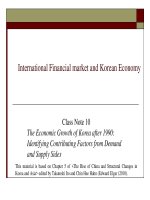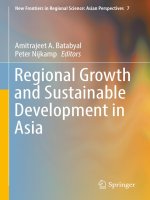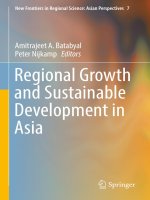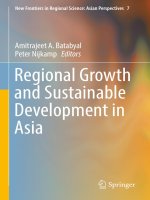Economic growth and economic development 199
Bạn đang xem bản rút gọn của tài liệu. Xem và tải ngay bản đầy đủ của tài liệu tại đây (44.4 KB, 1 trang )
Introduction to Modern Economic Growth
population. Figure 4.4 shows the relationship between income per capita and urbanization (fraction of the population living in urban centers with greater than 5,000
inhabitants) today, and demonstrates that even today, long after industrialization,
there is a significant relationship between urbanization and prosperity.
Naturally, high rates of urbanization do not mean that the majority of the population lived in prosperity. In fact, before the twentieth century urban areas were
often centers of poverty and ill health. Nevertheless, urbanization is a good proxy
for average prosperity and closely corresponds to the GDP per capita measures we
are using to look at prosperity today. Another variable that is useful for measuring
pre-industrial prosperity is the density of the population, which is closely related to
urbanization.
Figures 4.5 and 4.6 show the relationship between income per capita today and
urbanization rates and (log) population density in 1500 for the sample of European
colonies. Let us focus on 1500 since it is before European colonization had an effect
on any of these societies. A strong negative relationship, indicating a reversal in the
rankings in terms of economic prosperity between 1500 and today, is clear in both
figures. In fact, the figures show that in 1500 the temperate areas were generally
less prosperous than the tropical areas, but this pattern too was reversed by the
twentieth century.
There is something extraordinary and unusual about this reversal. A wealth of
evidence shows that after the initial spread of agriculture there was remarkable persistence in urbanization and population density for all countries, including those that
were subsequently colonized by Europeans. Extending the data on urbanization to
earlier periods shows that both among former European colonies and non-colonies,
urbanization rates and prosperity persisted for 500 years or longer. Even though
there are prominent examples of the decline and fall of empires, such as Ancient
Egypt, Athens, Rome, Carthage and Venice, the overall pattern was one of persistence. It is also worth noting that reversal was not the general pattern in the world
after 1500. Figure 4.7 shows that within countries not colonized by Europeans in
the early modern and modern period, there was no reversal between 1500 and 1995.
There is therefore no reason to think that what is going on in Figures 4.5 and
4.6 is some sort of natural reversion to the mean. Instead, the Reversal of Fortune
185









